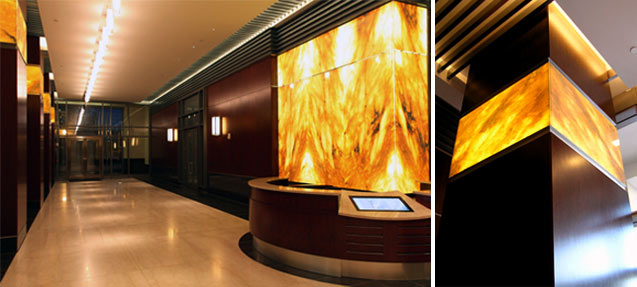Inherent Variances in Natural Stone and Onyx
Did you know that semi-precious stones are rated like diamonds as the rough blocks are pulled out of the ground? The variances found in natural stone can affect the maximum panel sizes, structural properties, degree of light transmission, and aesthetic elements of your design visions. GPI Design/GPI International president Thomas Lawrence discusses how to best utilize the design process to shape your natural stone selections.

In predicting the variances found in natural stone, one can only predict common background colors, or overall color shades. As a product of nature, it is these variances that identify natural stone from manmade stones; it is what sets natural stone apart from other design surfaces. Inherently, this can make for daunting approval processes & procedures found within the designer / client relationship. Quarries, suppliers and natural stone processors should use caution when supplying sample swatches of natural stones. .
Variances from one slab to the other can vary greatly in semi-precious natural stones such as:
- Quartz
- Onyx
- Alabaster
These stones produce dramatic and quite unique variances that can provide challenges to the quarry or supplier as predicting these variances can prove to be unreliable. It is suggested that overall tones be depicted through a general identifying name or color shade, ie, HONEY ONYX, MULTI-BROWN ONYX, VOLCANO ONYX, BLUE ONYX.
- Once a general shade has been identified, clients should be made aware of the stones typical and most recognizable characteristics, i.e., striated veining, cloud type appearance, cross cut characteristics and vein cut characteristics alike. It is only by identifying the general color tone and then recognizing the stones typical characteristics can a semi-precious stone be identified more clearly.
- The client should consider obtaining ACTUAL photographs of current stones being quarried at the time of approval, for approval.
- Samples can then be obtained after a “hold” has been placed on the stone in question.
- If then, it is approved; the stone then can be processed from the stock being held.
In many cases natural stones are given names. Beware; these generalizations are far too encompassing to provide any accuracy when attempting to select a stone for processing. For example, HONEY ONYX should only communicate the overall tone and base color for the stone. Among HONEY ONYX itself, we know of over 30 varieties with many different characteristics and tones. Selecting such a variety can only come from a recent digital image from a trusted and knowledgeable supplier or via personal visit to the quarry yard itself.
-By Thomas Lawrence, GPI President
FROM THE MARBLE INSTITUTE OF AMERICA:
“Onyx is often confused with marbles, yet it is a significantly different rock type. Onyx is a sedimentary rock, formed as stalactites and stalagmites in cave interiors. This formation method results in the cryptocrystalline construction of the rock fabric, and it is the size and uniformity of these crystals that contribute to the classic translucent property of most onyx varieties. Characteristics of quarried stone are dependent upon the attributes of the deposit from which the stone was extracted; each quarry is able to offer a range of products unique in dimensions, color, and structural properties to its deposit. Therefore, it is preferable that the designer and stone supplier collaborate closely prior to and throughout the design process since planning a project around readily available stone reduces the environmental impact of raw material extraction.”
